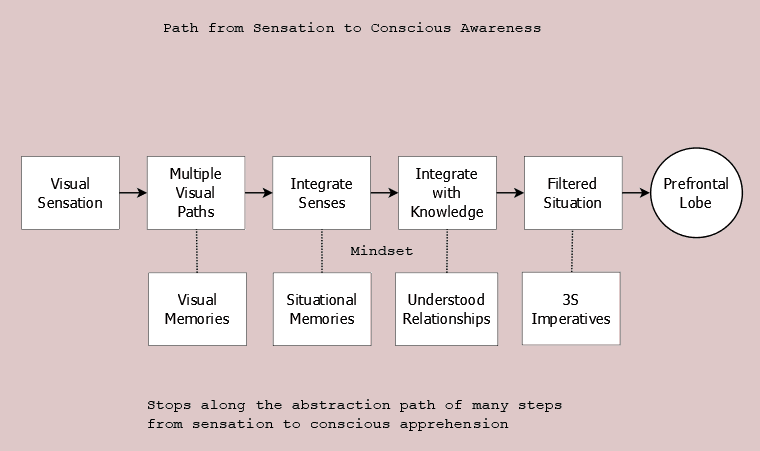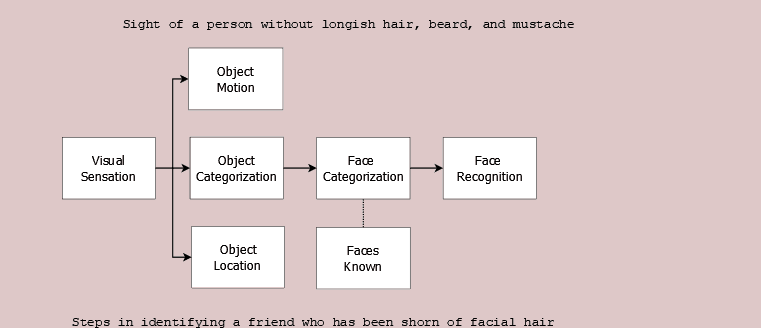Association in psychology refers to a mental connection between concepts, events, or mental states. What is this mental connection? How does it operate?
John Locke in An Essay Concerning Human Understanding (p 249) gives us the example of association formed between goblins and darkness in a child’s mind, because the maid always tied them together. The link between two independent ideas, goblins and darkness, is established because they were always mentioned together, not because there is a logical link between them. This reveals an essential feature of the associative link. It is not a logical link. Instead, association arises from happenstance.
Abstraction
As we have seen, when impulses arrive at a neuron, the Almost Gate strips out impulse detail, homogenizing the impulses. This abstraction of detail continues on every step the pattern (named or unnamed) travels on its journey towards conscious awareness. In Neural Cascade, the considerable loss of specificity was discussed in an arithmetic manner.
Before I proceed, let me recap the neural situation. Both abstraction and categorization are taking place. Each neural layer (cell assembly) settles on a winning neuron (categorization), while the winning neuron’s Almost Gate function abstracts in its output.
Sensory Path to Awareness
To be concrete, let’s consider vision, the many abstractions it goes through and the many category sieves it travels through. These category sieves are sites of potential associations. This discussion focuses on an adult’s mental operations–that is, basic learning of categories is complete, except in the upper reaches of the cortex.

The diagram shows multiple significant way stations of the raw visual as it proceeds to awareness.
- Multiple Visual Paths. These neural assemblies resolve edges, color, motion, and position. An important path handles face recognition–comparing with memories.
- Integrate Senses. Meld sound, touch, smell, and taste into a consistent whole. Compare the current situation with past situations (if the current situation triggers the same neurons as a past situation, then the next step in the path will be the same as the previous one’s step).
- Integrate with knowledge. The current situation is compared to one’s mindset. Understood relationships are forced upon the abstracted situation, resulting in a better fit upon less detail.
- Filtered Situation. Our understanding of the current situation travel through pathways which satisfy our needs, wants, and desires, filtering for potentialities implicit in the current situation
- Prefrontal Lobe. Some sensations then trigger awareness which we can then make conscious decisions upon.
Substitution of Abstracted Pattern
One type of association is the substitution of an abstracted pattern by another. Let’s consider we see a face (mine, many years ago) shaven with previously bearded.
How does your brain process the current face? What are the neural processes which are operating?

In this diagram, the initial visual information is processed in parallel along three paths
- Identify the object. Our main interest
- Locate the object
- Detect if the object is moving
Currently, there are 15 known visual processing steps, some in parallel, some in series, and others integrating. That detail is not essential in this discussion.
Once the object is categorized as a face the pattern passes through the fusiform gyrus (Kalat p 170) where recognition (identification) occurs.How does this identification occur?
The current pattern (sans longish locks, mustache, beard, and glasses) travels through the same neural layer that remembered faces have traversed. If the current pattern triggers the same winning neuron that a memory did, then the face is recognized.
Substitution of Abstracted Memory
This recognition is a substitution of a stored memory, an abstracted pattern learned in the past, for the current sensory input.
Other memories are stimulated in a center-surround structure as described by Manfred Spitzer (p 95) which involve that items that occurred with that person become more easily triggered by the current pattern of the person.Individuality of Recognition
There is no guarantee that each of us will recognize the same, altered looks of friends. Often we do, but if the change is too dramatic for the detail that repeated exposures to our friend’s face has laid down in our neural layer, that person may remain an unrecognized face.
Association, Similarities, and Different Level of Abstractions
The example of facial recognition is an early step with the substitution of a remembered, abstract pattern for the current image. Similar substitutions can occur when the current situation is compared (traverses the neural layers) of
- Our social and cultural beliefs
- The order that learned knowledge use
- The emotional colors of our 3S imperatives.
Other avenues discussing related points are: concept elevator, neural cascade, and induction operation.



2 Comments